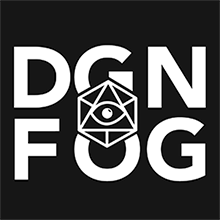City Landmarks
Today, Baldur’s Gate is split into three districts: the wealthy Upper City on the hills above the docks, the bustling Lower City around the harbor, and the lawless Outer City (which includes all neighborhoods outside the city walls). Regardless of what district one might be visiting, certain features are impossible to ignore, like the wash of Gray Harbor, the shadows of Dusthawk Hill, or the gates that contribute to the city’s name.
Important landmarks are marked on the large map of the city (map 6.2), which shows the entirety of Baldur’s Gate and its immediate surroundings.
The Gates
Nine gates separate the districts of Baldur’s Gate, providing the only points of entry to pass from the Upper City to the Lower City, or from the walled city proper to the Outer City and the wider world beyond. Baldurians, particularly if they do not wish to reveal a crew or family affiliation to a potentially hostile audience, often describe themselves by the nearest gate to their homes. Terms like “Gondgater” and “Dragongater” are widely understood as neighborhood identities, and are also understood as a way of eliding more troublesome connections. The Watch guards gates leading to the Upper City, while the Flaming Fist oversees the rest. Guards assigned to Baldur’s Gate and Black Dragon Gate stay at sharp attention and seldom accept bribes. Those assigned to the smaller and more secluded gates, however, can be less attentive, particularly when distracted by jingling coins. Anyone entering the city must pay a nominal entry toll of 5 cp. While this is a small sum, it ensures that the truly destitute remain outside, consigned to the slums of the Outer City. Beggars and refugees crowd at the fringes of these slums, typically around Black Dragon Gate and Basilisk Gate, pleading for money to pay the toll and hoping that the guards won’t drive them off for annoying more prosperous travelers. When the city is not under lockdown, merchants pour through the external gates from morning till night, while peddlers, delivery carriers, and servants move in equally swift streams through the inner gates. Toll collectors work quickly but methodically to inspect incoming and outgoing trade goods, ensuring that commerce flows smoothly and the city gets its share at every turn. The city gates are closed at night. At dusk, the Watch evicts anyone from the Upper City who is not a patriar, bearing a patriar’s livery or permission letter, or carrying a Watch-issued token. The enforcement of this rule is one of the means by which the Upper City reinforces its snobbery over the other districts. More than one Lower City merchant visiting an Upper City restaurant or theater near sundown has been embarrassed by a Watch member’s loud, public caution that the gates are about to close. While being seen hurrying toward the gates is an obvious embarrassment, being caught and escorted out would be far more bruising — both to one’s ego and body. The nightly closing of the gates ostensibly keeps the patriars safe. Closing off the Upper City pushes street crime into poorer neighborhoods, or out of the city altogether. In the Upper City, patriars can walk down alleys with relatively little fear, but beyond its well-lit streets and tightly watched gates, the other districts become much more dangerous after dark.Gray Harbor
One of the largest and deepest harbors on Faerûn’s western coast, Gray Harbor is also one of the busiest. The city’s independence and general laissez-faire attitude toward the types of goods and people flowing through its port — so long as the Government gets its cut — means that the harbor throngs with both honest captains conducting forthright trade and pirate crews looking to fence their wares. Plenty of sailors also make their homes nearby in the Lower City. The harbor’s most immediately striking feature is its machinery, with dozens of enormous cranes and countless powered scoops and cargo carts dramatically accelerating the loading and unloading process. Though designed by the Church of Gond, these marvels are run by the Harborhands, the most powerful crew in the city thanks to the dockworkers’ ability to shut off the city’s economic lifeblood with a strike. Managing the whole affair is Harbormaster Darus Kelinoth, a lawful neutral male human noble who runs the port’s operations and taxation from a small, heavily fortified brick building set well apart from other structures. The port itself is a tangle of piers, floating docks, and anchorages, from the massive Freighter’s Finger pier catering to the heaviest barges to the more ordinary slips at Northtree or Commonsdock. Not actually attached to shore, the chaotic Flotilla is the city’s cheapest long-term moorage option, where boats are welcome to raft together around common anchor buoys, and where some houseboats haven’t moved in generations. A special division of the Flaming Fist called the Gray Wavers patrols the harbor, yet it’s no secret that the more expensive docks are safer than the budget options. Sailors and even whole ships have been known to go missing in Gray Harbor, and while some assume such disappearances are the result of local shore-based pirates, others speak of Ol’ Cholms, a mysterious sea beast capable of dragging ships down to the river’s lightless bottom.Dusthawk Hill
East of the city, high above the scattered slums and cut-rate inns that stretch along the trade road, rises the steep yellow granite of Dusthawk Hill. This cliff-skirted hill is one of the last known refuges of the Chionthar dusthawk (use the hawk statistics), a once-common raptor whose numbers precipitously declined over the last century as regional turmoil and the ever-spreading slums outside Baldur’s Gate consumed its habitat. Local legend holds that the dusthawk was Balduran’s favorite hunting bird, and that the Chionthar population is descended from his own personal hunting hawks. When the dukes of Baldur’s Gate realized that the dusthawk was on the verge of extinction, they declared the hill, which included both the hawks’ cliffside nests and their hunting grounds, to be off limits to unlicensed hunters. Despite the fences and cliffs that cordon off most of the hill, trespassers remain common, the demand for dusthawk hunting birds having exploded among the wealthy. Many in the Outer City resent the hill being turned into private land. Several camps and slums were cleared as a result, their dwellers losing everything. The homeless resent the patriars for being willing to spend money giving hawks a home, but not them. Others resent the Flaming Fist guards who keep them from trapping on the hill. Stringy rabbits and scrawny quail made poor meals, but they were meals, and now many hunters have none. Rumors hold that werewolves lair in the sea caves under Dusthawk Hill, pretending to be ordinary smugglers — or ordinary animals — while plotting against the city. Whenever a grisly murder captures Baldurians’ imaginations, someone is always quick to claim that it must be one of the Dusthawk werewolves who did the deed.Remove these ads. Join the Worldbuilders Guild









Comments